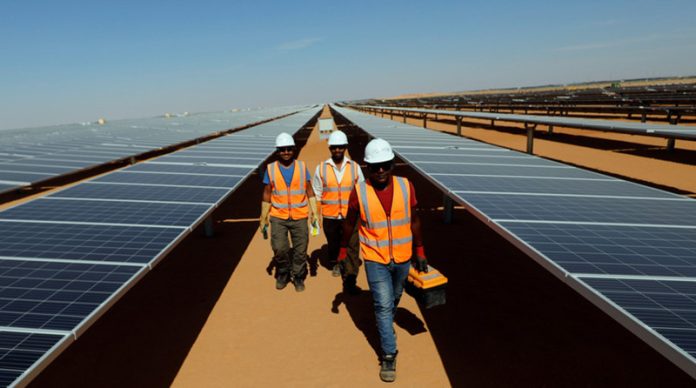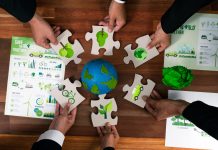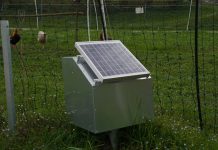By Ariane Evertz, Philipp Manuel Reynders, Sandra Felicitas Willert and Michael Palocz-Andresen
This paper aims to identify the positive effects that the global COVID-19 pandemic entails and how they can be retained within the social and economic recovery. The central finding is that the positive effects of reduced pollution, increased air quality and ecosystems recovery from human stressors need a technology push by the use of renewable energies and other green technologies alongside a societal pull into the direction of sustainability. Sustainable recovery is vital for our common future, for fighting climate change and diminishing health risks of future pandemics.
Introduction
The massive shock of the COVID-19 pandemic led to major changes in people’s lives, reducing mobility and thus social and industrial activities as well. The originated socio-economic disruption entailed various and, in most cases, positive consequences for the environment as well as great potential for future strategies of sustainability. Socio-economic changes occurred due to restricting policies like lockdowns and emerged from individual or societal adaptation strategies to the new situation like remote work.
The first part gives insight to the direct or indirect positive impact of the pandemic on environmental parameters like pollution, air quality or the condition of ecosystems and points out which socio-economic changes led to these improvements. The second part discusses the importance of renewable energy production and using for an environmental-friendly future. In the third part sustainability strategies will be considered, related to the “One Health” approach as one possible concept to strengthen society’s resilience towards future pandemics and further challenges.
Environmental Consequences of the COVID-19 Pandemic
The COVID-19 pandemic brought most social and economic activities to a halt as mobility was restricted to control the spread of the virus. The COVID-19 is primarily impairing the respiratory system and can even lead to death1. Counter steering policies like the mandatory use of face masks, social distance and lockdowns were enforced in the most affected countries worldwide and led to a huge socio-economic disruption which had more or less direct impact on the extent of emissions and pollution as well as on the condition of ecosystems 1.
Emissions and Air Quality
Transportation and industries are the major source of most pollutants and greenhouse gases (GHG) such as CO, CO₂, SO₂, NO₂ and particulate matter 1,2. These substances are harmful to human and environmental health by causing respiratory diseases, biodiversity loss and reinforcing climate change1. Even though the concentration of the individual air pollutants changed to a different extent, the concentration of particulate matter and NO₂ showed a significant drop, increasing the total air quality to good levels whereas GHG emissions dropped along with reduced consumption of fossil fuels and less energy demand, see Fig. 13.

These changes were especially visible for the world’s most polluted and densely populated cities that are most affected by rather unhealthy air quality levels as well. Air pollution is a crucial factor that affects the COVID-19 transmission, effect size and mortality rate as it causes several diseases that make the person concerned more vulnerable to infections1. Thus, not only COVID-19 can influence environmental factors but also vice versa. This means that we can prevent high infection rates in the future by changing our mobility and consumer habits as a healthy environment also facilitates better health conditions of the society.
Biodiversity and ecosystems
Biodiversity plays a major role in the emergence of pandemics. Deforestation and climate change mainly induce the current ongoing biodiversity loss that facilitates the spread of pathogens among populations. The ongoing destruction of the environment forces wildlife out of their natural habitats. This leads to wildlife shifting closer to urban areas which in-turn leads to more contact between wildlife and humans. The increased contact might result in a higher number of transmissions of zoonotic pathogens, such as SARS or Ebola, from their animal hosts onto humans4. This calls for an effective and sustainable protection and conservation of biodiversity, for instance by addressing deforestation as well as a drastic reduction of emissions for better air quality and healthier ecosystems5.
Due to restrictions in international travel, as well as local restrictions, ecosystems in and around tourist areas had time to recover and wildlife claimed back some of its territory. Though more medical waste is being produced due to the COVID-19 pandemic which poses new challenges for waste management authorities in the short-term, less waste in areas of tourism as well as less water, air and noise pollution had major effects on ecosystems in those areas1. For instance, rivers and seas reached a significant level of purity that could be observed by the changed water colour and the reappearance of many aquatic species in India, Italy and Thailand1.
Disruption as Incentive for Change
The vast changes in mobility and respectively human activities within the pandemic result in various short-term positive effects for society and the environment across the world. The local measures and observations reporting about these changes are references of a global phenomenon. Pollution and emissions tend to decrease significantly, hence improving air quality and quality of life whereas wildlife and ecosystems seem to recover from the absent intensive human activities1.
The current period indicates what range of benefits can be achieved from a lasting and sustainable reduction of economic and social activities as shown in Fig. 3. Disruptive events like the COVID-19 pandemic are proven to be vital factors in upsetting unsustainable business-as-usual practices in society and setting incentives for temporary or permanent change6. The before-mentioned positive effects on the environment and society are assumed to be only short-term and need a deep change in societal and economical structures to outlast the pandemic1.
Otherwise, positive trends will quickly go back to pre-lockdown status or even cause rebound effects that lead to an overshoot of previously projected emission levels despite decreased economic growth2. The adverse effects of global crises such as climate change or pandemics are disproportionately affecting world regions albeit their contribution to their origination, reinforcing the already existing injustice in the world. Sustainability strategies have great potential to secure a resilient recovery that is just, creates wealth and facilitates ecological restoration for the benefit of all, see Fig. 2.

Using Renewable Energies
The shut-down of economic activities resulted in a reduction of energy consumption and widely-reported environmental improvements1. These improvements, however, will diminish if large-scale industrial activities resume as before. For sustainable industrialization in post-pandemic times, it is essential to shift the industry sector to green technologies, energy efficiency, use of renewable energies and circularity to diminish the emissions of the industry without hampering the national economies, see Fig. 37,8,9.

Sustainable Future
Sustainability is especially important for economic recovery as the industry sector has to revitalize production and jobs in the face of supply-demand imbalances caused by restrictions and other policies related to the pandemic2, see Fig. 410.

The malfunction of today’s economy manifests not only in more obvious aspects like the sovereign debt crisis, economic stagnation and unemployment, but also in environmental pollution and reinforcement of climate change11.
The past showed that currently dominant practices and conceptions of economies, more precisely the separate treatment of pressing problems and the rest upon linear processes or the conception of unlimited economic growth, are rather leading to the amplification of these challenges than to their resolution12. Concepts of a slow-growth or no-growth economy aim to find an integrated solution that considers the complex interrelationships of economic, social as well as environmental challenges and to minimize the risk of rebound effects and lock-in to carbon-intensive industry structures13. The design of supporting structures where economic and social activities occur is essential for sustainability transitions3. Hence, green behaviour of companies and a sustainable industry would most likely induce a change in individual consumption patterns by acting as infrastructure that limits consumer choices on exclusively sustainable options of supply and services, thus is minimizing the occurrence of unsustainable consumption on the whole4.
Companies have a great responsibility in designing greener products for the market, nudging sustainable consumption behaviour and promoting low-carbon interventions5. Moreover, certain procedures adapted in the circumstances of the pandemic, like more hygienic workspaces with proper distances and home office, can be seen as guiding models to minimize the future risk of spreading of any infectious communicable disease and to increase the general flexibility of the personnel in post-pandemic times1. Cleaner production and sustainability considerations benefit the future health and industry. Policymakers have a key role in scaling up low-carbon interventions in industries by dedicating a share of the recovery budget to low-carbon measures and promoting already existing best-practices in the industry 14.
Most economic and social activities highly depend on the provision of energy15. Reverting economic growth and consumption will not allow for the perpetuation of lowered energy demand like the way it was induced by the exceptional situation of the pandemic and will increase emissions and pollution again1.
The extension of renewable energy systems can lower the demand for conventional energy sources, namely fossil fuels and nuclear energy – both are associated with considerable environmental pollution and health risks. While sufficiency – on individual and societal level – remains a pivotal strategy to pave the way for the resilient implementation of sustainability in industries, renewable energy sources like wind, solar, hydropower, geothermal heat and biomass play a crucial role in future energy production by avoiding resource-overuse and harmful pollution to make social and economic activities as clean as possible1.
Furthermore, green technologies such as electric vehicles will probably get more popular in the process of electrification and will increase the total demand for clean energy in the near future. The implementation of a renewable energy system hence needs to be accelerated by the provision of certain infrastructure such as grid extension or grid storage to stabilize the energy system against the rising energy demand and variable weather conditions. Investments should ideally be geared to minimize pollution and promoting the use of renewable energy sources13.
Energy systems play a crucial role in the sustainability transition. They help to make social and economic activities as clean as possible by avoiding resource-overuse and harmful pollution1. Amongst the various types of pollution, air pollution is one of the most urgent threats to human and environmental health. Air pollutants increase the mortality rate and cause several respiratory diseases like asthma1,2. In addition, air pollutants are also negatively affecting ecosystems and their biotic communities, for instance N- and PM-emissions pose a meaningful threat to biodiversity, especially in nutrient-poor ecosystems. This contributes to the ongoing biodiversity loss that diminishes ecosystem resilience and facilitates the spread of pathogens among populations, which increases the risk of transmissions of zoonotic pathogens from animal hosts to humans as well2. Consequently, air pollution is positively affecting the COVID-19 transmission rate in two ways – by making the person concerned more vulnerable to infections and by reinforcing the transmission rate of diseases among populations and onto humans.
Perspective on the Pandemic: One Health
Given the overarching impact not only anthropogenic air pollution but also all other human made influences have on the global ecological system, it is imperative to find an appropriate approach to this complex interconnectedness. The pandemic’s roots are to be found in human encroachment in ecosystems, as Córdoba-Aguilar et al. (2021) have pointed out the excessive land use and exploitation of natural spaces as well as resources, and the increased human mobility that help pathogens to reach all corners of the world. They compare the Corona pandemic to previous zoonoses like the HIV pandemic or the Spanish Flu. All in all, they state that all those emerged from “avoidable interactions” with ecosystems, which mainly means human encroachment in natural areas9. This includes illegal wildlife trading, which has especially been a debate in the Corona context, see Fig. 514.

As depicted in Fig. 5, most vector-borne diseases are directly or indirectly fuelled by the destruction of nature. Córdoba-Aguilar et al. (2021) also have summarized the main reasons why biodiversity and nature are crucial for pandemic prevention15. To begin, natural areas without human infrastructure serve as buffers between animal pathogen carriers and humans – high diversity among species helps stabilize and balance the ecosystem and prevents one species from multiplying exponentially. Moreover, the so-called dilution effect sets in when pathogens are distributed more evenly among several species. A previously mentioned risk for zoonoses is the illegal handling of wildlife and the accompanying degradation of natural spaces. The authors’ fourth mentioned aspect is climate change and deforestation, as the rising temperatures create the possibility for certain vectors to spread to different areas than before.
The last and maybe most fundamental issue is the unsolved contradiction of growth-fixated capitalism and the planetary boundaries and the requirement for nature to regenerate and restore. This is the driver of all of the aspects mentioned above, and it is time to rethink our relationship to nature, if we seek to prevent or at least mitigate the climate crisis, future pandemics and suffering in general15.
The concept of viewing the earth as one ecologically interconnected system with human health, nature and biodiversity as interacting parts is called One Health. Each element’s state of the One Health concept is dependent on the wellbeing of the other elements. Although we are far from understanding the earth system’s complex reciprocities, it is worth assuming that biodiversity generally serves our planet’s health. On the individual level, research has shown how interaction with nature, such as visiting the park or the forest, can significantly enhance mental and physical health.
Moreover, transdisciplinary research is one of the concept’s cornerstones. It is based on informing communities, raising awareness for the importance of ecosystem preservation, as well as about benefits people can personally get from taking part in restoration efforts. Also, cooperation not only between different international researchers, but also with indigenous communities is crucial for successful conservation because of their valuable locally shared knowledge. Another reason to promote One Health is the endeavour to directly work with stakeholders who are and will be affected by the consequences of nature’s deterioration, and at last, to create a bridge between scientists and policymakers to actively change real-world circumstances for the better14. One Health needs to be administered on a global level, see Fig. 6.

To avoid future pandemics there is a need for “a healthy balance between prevention and treatment”13. According to Breed et al. (2020) COVID-19 is a wake-up call for humanity to shift its focus to ecosystem restoration as a public health intervention. “The required paradigm shift can be supported by recognition that ecological degradation is driving many public health problems, and we cannot solve these public health problems without tackling ecological degradation”16. The transdisciplinary research collective has exposed two major knowledge gaps: The lack of a “quantification of individual health benefit”, as well as “population health benefits” that come from ecological restoration16. Moreover, they developed a transdisciplinary action plan that is necessary for establishing an empirical scientific basis for future research to rely upon.
Breed et al. (2020) emphasize the necessity to define causalities between ecological restoration and human health benefits. In order to gain a quantitative foundation, research must monitor both restoration and health outcomes for evaluation. Another point addresses the importance of interaction with local communities. These need to participate in the research process in order to gain knowledge as diverse as possible. Lastly, only through decision-makers it is possible to implement the necessary restoration measures. To sum it up, Breed et al. (2020) make a case for ecological restoration: They see it as “a clearly identifiable pathway to tackle some of our most critical challenges, as it becomes increasingly clear that the human and ecological health crises are intimately interwoven”17.
Outlook
Global challenges like future pandemics and climate change will only be overcome if we acknowledge the interweaving of human and ecological health. Ecological restoration and biodiversity conservation will be imperative regulators. The experience of this devastating pandemic must serve as a leverage point for dramatic structural change and international cooperation if we seek to save lives, ecosystems and perspectives for future generations.
Renewable energies are key to decouple any social or economic activity from high resource use and pollution, which is why they need to be promoted. Investments in sustainability innovations and processes should be highly encouraged as it is comprehensively worthwhile for mitigating risks, saving costs as well as facilitating a healthy and secure life now and in the future. Further efforts are needed in ecosystem protection, but also regulation of wildlife markets and factory farming for meat production is crucial.
The One Health concept is a way to do justice to the complexity of the world’s environmental interconnectedness and the approach has the potential to unify scientists and civilians on an international transdisciplinary level. The concept brings a fundamental issue to light: The way we comprehend wealth is not aligned at all with the goal of universal wellbeing and ecological and social health. It is essential to rethink our definition of prosperity at this point and foster inter- and transdisciplinary research on cross-sectorial sustainability to successfully mitigate risks of global challenges.
Conclusion
This paper aimed at elaborating the effects on the environment that came from socio-economic restrictions due to the COVID-19 pandemic as well as the role of environmental destruction in the emergence of such pandemics with emphasis on the close interconnectedness of human health and the health of ecosystems. During lockdown periods, major improvements in emissions have been observed in areas that were especially exposed to low air quality before. As air quality facilitates a healthy environment and society, it becomes clear that air pollution also has a major impact on the transmission rate of pathogens.
The authors would like to thank Prof. Maik Adomßent for years of support for the above seminar series in the Complementary studies at the Leuphana University Lüneburg, Germany.
This article was originally published in The European Financial Review 11 February 2022. It can be accessed here: https://www.europeanfinancialreview.com/renewable-energy-use-after-the-pandemic/
About the Authors

Ariane Evertz has been studying cultural studies at the Leuphana University Lüneburg and sustainability science since 2019. She is engaged in sustainability projects like Food-Coops and Lüneburg 2030+, the latter aiming at a sustainability transformation starting from city communities.

Philipp Manuel Reynders studies business administration with a focus on marketing management and social media and information systems as his minor at the Leuphana University Lüneburg, Germany. He worked as a freelance project assistant for the “German Social Accident Insurance for the Health and Welfare Services”.

Sandra Felicitas Willert studies environmental sciences and spatial sciences. at the Leuphana University Lüneburg, Germany Her studies incorporate natural sciences such as basic chemistry and ecology as well as social sciences such as sustainability communication and environmental education.

Michael Palocz-Andresen has been working as Herder-professor since 2018, supported by the DAAD at the TEC de Monterrey Mexico. He became a full-professor at the University West-Hungary, a guest professor at the TU Budapest, the Leuphana University Lüneburg and the Shanghai Jiao Tong University. He is a Humboldt scientist and an instructor of the SAE International in the USA
References
- Rume, T.; Islam, S. M. D.: Environmental effects of COVID-19 pandemic and potential strategies of sustainability. DOI: 10.1016/j.heliyon.2020.e04965
- Cox, A.; Piccolo, A.: Environmental health and strengthening resilience to pandemics, Organisation for Economic Co-operation and Development. Online available at: https://read.oecd-ilibrary.org/view/?ref=129_129937-jm4ul2jun9&title=Environmentalhealth-and-strengthening-resilience-to-pandemics (November 28, 2020)
- Hamburger Luftmessnetz Monatsdaten März 2021. https://luft.hamburg.de/contentblob/15019548/bfda78a594f77a7d079084d3d3e180a5/data/monatsdaten-2103.pdf (Jun 08, 2021)
- Kuhnhenn, K.; Coast, L.; Mahnke, E.; Schneider, L.; Lange, S.: A Societal Transformation Scenario for Staying Below 1.5°C. Volume 23 of the Publication Series Economic & Social Issues. Heinrich Böll Foundation and Konzeptwerk Neue Ökonomie 2020
- Solimini, A.; Filipponi, F.; Alunni Fegatelli, D.; Vestri, A. R.: A global association between Covid-19 cases and airborne particulate matter at regional level. Sci Rep 11, 6256 (2021). https://doi.org/10.1038/s41598-021-85751-z, (May 19, 2021)
- Chiu, A. S. F.; Aviso, K. B.; Baquillas, J.; Tan, R. R.: Can disruptive events trigger transitions towards sustainable consumption? Cleaner and Responsible Consumption 1 (2020) 100001. DOI: 10.1016/j.clrc.2020.100001
- The impact of COVID-19 on the energy transition. https://www.dnv.com/energy-transition/impact-of-covid19-on-the-energy-transition.html (June 13, 2021)
- Special Report on Emissions Scenarios. https://en.wikipedia.org/wiki/Special_Report_on_Emissions_Scenarios (Juni 13, 2021)
- World total final consumption (TFC) by source. https://www.google.com/search?client=firefox-b-d&q=world+final+energy+demand (June 13, 2021)
- Sustainable Development and its Challenges in Developing Countries. https://medium.com/@iynf/sustainable-development-and-its-challenges-in-developing-countries-487a333184a0 (June 13, 2021)
- Kanda, W.; Kivimaa, P.: What opportunities could the COVID-19 outbreak offer for sustainability transitions research on electricity and mobility. Energy Research & Social Science 68 (2020), 101666. DOI: 10.1016/j.erss.2020.101666
- Ayres, Robert U.; Campbell, C. J.; Casten, T. R.; von Weiszäcker, E. U.: Sustainability transition and economic growth enigma: Money or energy? Environmental Innovation and Societal Transformations 9 (2013), 8-12. DOI: 10.1016/j.eist.2013.09.002
- Burck, J.; Hagen, U.; Bals, C.; Lucas, B.: Climate Change Performance Index. Results. Climate mitigation efforts of 57 countries plus the EU. Covering 90% of the global greenhouse gas emissions. Online available at: https://ccpi.org/download/the-climatechange-performance-index-2021/ (March 01, 2021)
- UN environment programme, https://twitter.com/unep/status/1250697346071085057 (June 13, 2021)
- Córdoba-Aguilar, A., Ibarra-Cerdeña, C. N., Castro-Arellano, I. & Suzan, G.: Tackling zoonoses in a crowded world: Lessons to be learned from the COVID-19 pandemic. Acta tropica, 214, 105780. https://doi.org/10.1016/j.actatropica.2020.105780
- Smiley Evans, T.; Grange, Z.; Belkhiria, J.;Mazet, J.: Beyond COVID-19: Conserving nature to prevent the next pandemic. Parks Stewardship Forum, 37(1). https://doi.org/10.5070/P537151713
- Breed, M. F.; Cross, A. T.; Wallace, K.; Aronson, J.: Ecosystem Restoration: https://link.springer.com/article/10.1007/s10393-020-01480-1 (May 19, 2021)





































































